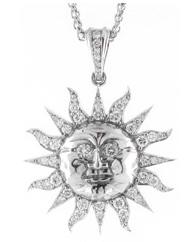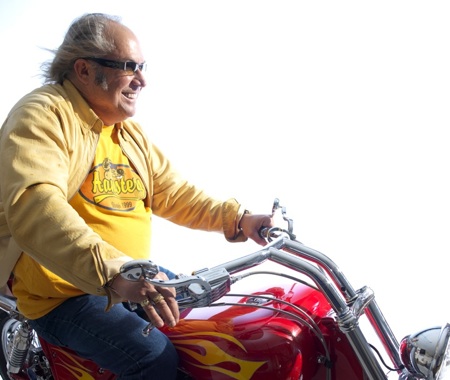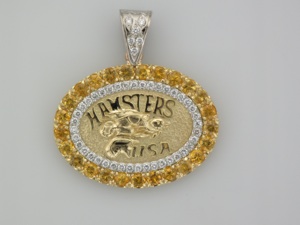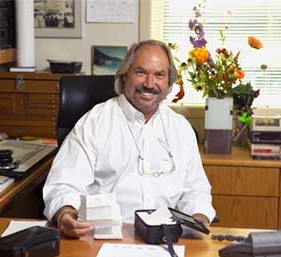Articles and News
NO TREADMILL FOR THIS HAMSTER! IDAHO JEWELER COMMITTED TO RAISING MONEY FOR LOCAL KIDS’ HOSPITAL | November 30, 2011 (1 comment)

Ketchum, ID—Barry Peterson likes building things. Sometimes it’s the precious little things the customers of his eponymous store crave, like his signature sun (shown left), occasionally it’s a house or other building, and sometimes it’s very big noisy things that go very fast. For when he’s not at the bench, this jeweler is most likely to be in the garage, since he’s a member of one of the most elite group of custom motorcycle builders, the Hamsters.
The organization, founded in 1978, has about 450 members worldwide who build custom bikes. Membership isn’t just for tinkerers, though—it’s a very serious process to be accepted, requiring both an invitation from an existing member and a jurying process to prove your bike-building skills are up to par.
Peterson himself has two custom motorcycles. The first he actually got in trade from a jewelry rep, Dave Perewitz, one of the original Hamsters. He customized it over the course of six months, and it now stands in the entry hall of his house. For his second, he bought a new Harley Davidson, disassembled it, and rebuilt it entirely as a custom bike.

The jeweler on one of his two custom bikes, wearing a gold Hamsters T-shirt.
So how did a bunch of bikers—not an image associated with soft, warm, furry little rodent pets—get named the Hamsters? And even more strangely, how did the jewelry industry have a hand in it?
It was the founding joke of the club. During Daytona Bike Week in 1978, there was a small group of about six or seven custom bikers in attendance, all friends. Susan Perewitz (Dave’s wife) and another biker, Jim Leahy, had retired to their respective motel rooms to catch a few zzz’s. When they woke up, they found the rest of the gang had gone for a long ride without them.
“What a bunch of hamsters,” said Jim. A few beers later, he grabbed a paper plate and sketched a cartoon rodent with the words “Hamsters MC” above it. Not content to stop there, he drew six more, one for each of the offenders, designating each as the president of his respective region. But the guys really got a kick out of the signs, and they all agreed to meet again at a well-known bike rally in Sturgis, SD. There, another member came up with the idea of creating Hamsters T-shirts, and picked a golden yellow color instead of the usual biker black.
Within a short time, the group had grown to 40 or 50. But then it went through some tough times, coinciding with the acquisition of Harley-Davidson by AMF, which, in the words of this article in Street Chopper magazine, “did the same thing for Harley-Davidson that the new cast did for SNL: made it suck until the middle of the decade.” After Harley was divested from AMF, it reinvented itself and turned itself around, and with it the Hamsters grew like, well, hamsters. It was then the group established tough credentials for joining. It has since become famous in the biker world and even somewhat known outside it, as the subject of a special on the Discovery Channel.
“Members come from all over the world,” says Peterson. “Most of the [members’] bikes are based around Harley style, but they’re not Harley parts. They’re all custom. It’s rolling jewelry, basically.” During the Sturgis bike rally, Hamsters roll into town in their famous T-shirts, like a “big yellow army,” as Peterson puts it. Their bikes are even put on display at the civic center for the public to view.
Peterson builds a lot of the club’s non-rolling jewelry. “Other guys build some but mine is the finest,” he says. The pendant below features the Hamsters logo in a sun of yellow sapphires.

Even in the wilds of Idaho, the jewelry tradition is born in the blood. Peterson’s father, Reed Lawrence Peterson, was “a true rock hound and mining aficionado,” says the store’s web site. Prospecting was an adjunct to the elder Peterson’s day job as a potato farmer. (This is, after all, Idaho.) But he instilled his passion for prospecting and lapidary in his sons, and Barry turned an avocation into a vocation. He’s traveled the globe from the gem mines of Brazil to watchmakers’ studios in Geneva to hone his craft, and among the original designs he’s known for is the Sun Valley Sun, shown at the top of this page, originally a piece for the Sun Valley company and now a signature piece for Barry Peterson Jewelers.

A more familiar view of Barry Peterson, in his jewelry store.
But what Peterson is most proud of isn’t his mechanical skills or even his bench work. It’s giving back. On his own, he’s active in local philanthropy and supporting the arts community. And he waxes proudly about how much money the Hamsters raise for charity, mainly children’s hospitals, and especially Children’s Care Hospital and School in Sioux Falls and Rapid City, SD. The organization offers a wide range of health care and education services from mild learning challenges to intense medical rehabilitation, that cover children from birth to age 21.
“The Hamsters have raised almost as much as everyone else combined,” says Peterson proudly. Annual fundraising events have netted as much as $300,000 a year for the hospital, and over the course of time have included such themes as silent auctions and even a live bike auction from a Hamster who died of cancer shortly after becoming a member. His sister donated the bike to the hospital for a fundraising raffle. The raffle winner then donated it back, where a live auction during the Hamsters’ annual gala raised even more money.







